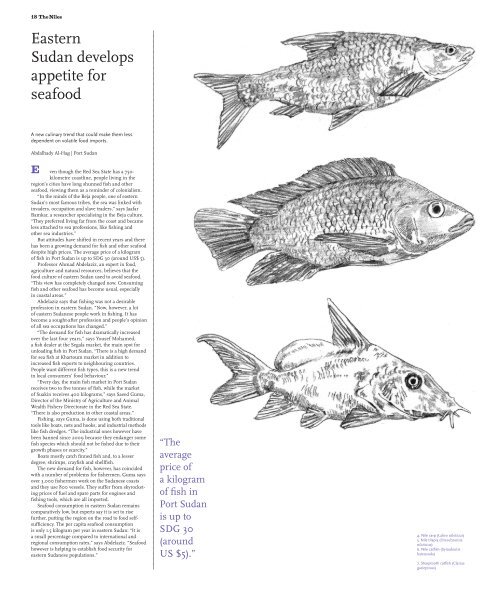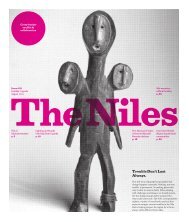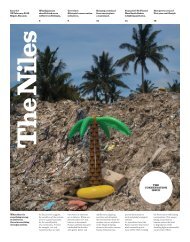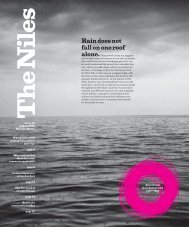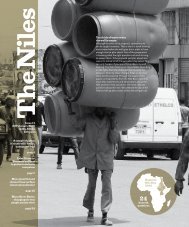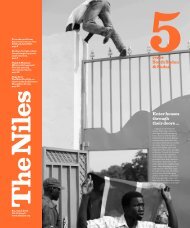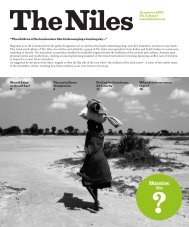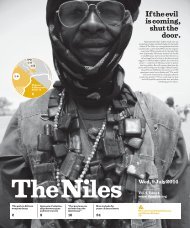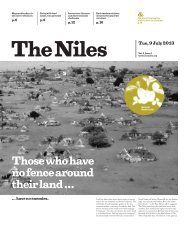A fool will not even find water in the Nile!
The Sudanese proverb raises the question: Does the fool drown in his search for water or is he saved by it? And who is, in fact, this fool? Given the wasteful and unfair dealings of mankind with this dwindling resource – aren’t we all? While doing research on water, The Niles correspondents in South Sudan and Sudan met fishermen who deal carefully with the water that nourishes them and business people who exploit the resource without restraint. They report on conflicts around water but also on exemplary projects where water is shared peacefully. In short, the fool is still swimming, but for how long?
The Sudanese proverb raises the question: Does the fool drown in his search for water or is he saved by it? And who is, in fact, this fool? Given the wasteful and unfair dealings of mankind with this dwindling resource – aren’t we all? While doing research on water, The Niles correspondents in South Sudan and Sudan met fishermen who deal carefully with the water that nourishes them and business people who exploit the resource without restraint. They report on conflicts around water but also on exemplary projects where water is shared peacefully. In short, the fool is still swimming, but for how long?
You also want an ePaper? Increase the reach of your titles
YUMPU automatically turns print PDFs into web optimized ePapers that Google loves.
18 The <strong>Nile</strong>s<br />
Eastern<br />
Sudan develops<br />
appetite for<br />
seafood<br />
A new cul<strong>in</strong>ary trend that could make <strong>the</strong>m less<br />
dependent on volatile food imports.<br />
Abdalhady Al-Hag | Port Sudan<br />
E ven though <strong>the</strong> Red Sea State has a 750-<br />
kilometre coastl<strong>in</strong>e, people liv<strong>in</strong>g <strong>in</strong> <strong>the</strong><br />
region’s cities have long shunned fish and o<strong>the</strong>r<br />
seafood, view<strong>in</strong>g <strong>the</strong>m as a rem<strong>in</strong>der of colonialism.<br />
“In <strong>the</strong> m<strong>in</strong>ds of <strong>the</strong> Beja people, one of eastern<br />
Sudan’s most famous tribes, <strong>the</strong> sea was l<strong>in</strong>ked with<br />
<strong>in</strong>vaders, occupation and slave traders,” says Jaafar<br />
Bamkar, a researcher specialis<strong>in</strong>g <strong>in</strong> <strong>the</strong> Beja culture.<br />
“They preferred liv<strong>in</strong>g far from <strong>the</strong> coast and became<br />
less attached to sea professions, like fish<strong>in</strong>g and<br />
o<strong>the</strong>r sea <strong>in</strong>dustries.”<br />
But attitudes have shifted <strong>in</strong> recent years and <strong>the</strong>re<br />
has been a grow<strong>in</strong>g demand for fish and o<strong>the</strong>r seafood<br />
despite high prices. The average price of a kilogram<br />
of fish <strong>in</strong> Port Sudan is up to SDG 30 (around US$ 5).<br />
Professor Ahmad Abdelaziz, an expert <strong>in</strong> food,<br />
agriculture and natural resources, believes that <strong>the</strong><br />
food culture of eastern Sudan used to avoid seafood.<br />
“This view has completely changed now. Consum<strong>in</strong>g<br />
fish and o<strong>the</strong>r seafood has become usual, especially<br />
<strong>in</strong> coastal areas.”<br />
Abdelaziz says that fish<strong>in</strong>g was <strong>not</strong> a desirable<br />
profession <strong>in</strong> eastern Sudan. “Now, however, a lot<br />
of eastern Sudanese people work <strong>in</strong> fish<strong>in</strong>g. It has<br />
become a sought-after profession and people’s op<strong>in</strong>ion<br />
of all sea occupations has changed.”<br />
“The demand for fish has dramatically <strong>in</strong>creased<br />
over <strong>the</strong> last four years,” says Yousef Mohamed,<br />
a fish dealer at <strong>the</strong> Segala market, <strong>the</strong> ma<strong>in</strong> spot for<br />
unload<strong>in</strong>g fish <strong>in</strong> Port Sudan. “There is a high demand<br />
for sea fish at Khartoum market <strong>in</strong> addition to<br />
<strong>in</strong>creased fish exports to neighbour<strong>in</strong>g countries.<br />
People want different fish types, this is a new trend<br />
<strong>in</strong> local consumers’ food behaviour.”<br />
“Every day, <strong>the</strong> ma<strong>in</strong> fish market <strong>in</strong> Port Sudan<br />
receives two to five tonnes of fish, while <strong>the</strong> market<br />
of Suak<strong>in</strong> receives 400 kilograms,” says Saeed Guma,<br />
Director of <strong>the</strong> M<strong>in</strong>istry of Agriculture and Animal<br />
Wealth Fishery Directorate <strong>in</strong> <strong>the</strong> Red Sea State.<br />
“There is also production <strong>in</strong> o<strong>the</strong>r coastal areas.”<br />
Fish<strong>in</strong>g, says Guma, is done us<strong>in</strong>g both traditional<br />
tools like boats, nets and hooks, and <strong>in</strong>dustrial methods<br />
like fish dredges. “The <strong>in</strong>dustrial ones however have<br />
been banned s<strong>in</strong>ce 2009 because <strong>the</strong>y endanger some<br />
fish species which should <strong>not</strong> be fished due to <strong>the</strong>ir<br />
growth phases or scarcity.”<br />
Boats mostly catch f<strong>in</strong>ned fish and, to a lesser<br />
degree, shrimps, crayfish and shellfish.<br />
The new demand for fish, however, has co<strong>in</strong>cided<br />
with a number of problems for fishermen. Guma says<br />
over 3,000 fishermen work on <strong>the</strong> Sudanese coasts<br />
and <strong>the</strong>y use 800 vessels. They suffer from skyrocket<strong>in</strong>g<br />
prices of fuel and spare parts for eng<strong>in</strong>es and<br />
fish<strong>in</strong>g tools, which are all imported.<br />
Seafood consumption <strong>in</strong> eastern Sudan rema<strong>in</strong>s<br />
comparatively low, but experts say it is set to rise<br />
fur<strong>the</strong>r, putt<strong>in</strong>g <strong>the</strong> region on <strong>the</strong> road to food selfsufficiency.<br />
The per capita seafood consumption<br />
is only 1.5 kilogram per year <strong>in</strong> eastern Sudan: “It is<br />
a small percentage compared to <strong>in</strong>ternational and<br />
regional consumption rates,” says Abdelaziz. “Seafood<br />
however is help<strong>in</strong>g to establish food security for<br />
eastern Sudanese populations.”<br />
“The<br />
average<br />
price of<br />
a kilogram<br />
of fish <strong>in</strong><br />
Port Sudan<br />
is up to<br />
SDG 30<br />
(around<br />
US $5).”<br />
4. <strong>Nile</strong> carp (Labeo niloticus)<br />
5. <strong>Nile</strong> tilapia (Oreochromis<br />
niloticus)<br />
6. <strong>Nile</strong> catfish (Synodontis<br />
batensoda)<br />
7. Sharptooth catfish (Clarias<br />
gariep<strong>in</strong>us)<br />
<strong>the</strong>niles6_20151123.<strong>in</strong>dd 18<br />
2015/11/23 2:13 PM


